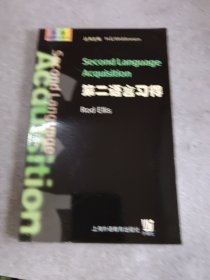
第二语言习得(牛津语言学入门丛书)
¥ 1 八五品
仅1件
浙江台州
认证卖家担保交易快速发货售后保障
作者埃利斯 作者
出版社上海外语教育出版社
出版时间2005-09
版次1
装帧平装
上书时间2024-05-21
- 在售商品 暂无
- 平均发货时间 9小时
- 好评率 暂无
- 最新上架
商品详情
- 品相描述:八五品
- 商品描述
- 29
图书标准信息
- 作者 埃利斯 作者
- 出版社 上海外语教育出版社
- 出版时间 2005-09
- 版次 1
- ISBN 9787810467940
- 装帧 平装
- 开本 其他
- 纸张 其他
- 正文语种 简体中文
- 【内容简介】
- 第二语言习得:Second language acquisition,ISBN:9787810467940,作者:埃利斯,Ellis著
- 【作者简介】
- 作者:(英)埃利斯
- 【目录】
-
Preface
Section 1: Survey
1. Introduction: describing an explaining L2 acquisition
1.1 What is ‘second language acquisition’?
1.2 What are the goals of SLA?
1.3 Two case studies
(1) A case study of an adult learner
(2) A case study of two child learners
1.4 Methodological issues
1.5 Issues in the description of learner language
1.6 Issues in the explanation of L2 acquisition
2. The nature of learner language
2.1 Errors and error analysis
(1) Identifying errors
(2) Describing errors
(3) Explaining errors
(4) Error evaluation
2.2 Developmental patterns
(1) The early stages of L2 acquisition
(2) The order of acquisition
(3) The sequence of acquisition
(4) Some implications
2.3 Variability in learner language
2.4 Summary
3. Inter-language
3.1 Behaviorist learning theory
3.2 A mentalist theory of language learning
3.3 What is ‘inter-language’?
3.4 A computational model of L2 acquisition
4. Social aspects of inter-language
4.1 Inter-language as a stylistic continuum
4.2 The acculturation model of L2 acquisition
4.3 Social identity and investment in L2 Learning
5. Discourse aspect of inter-language
5.1 Acquiring discourse rules
5.2 The role of input and interaction in L2 acquisition
5.3 The role of output in L2 acquisition
5.4 Summary
6. Psycholinguistic aspects of inter-language
6.1 L1 transfer
6.2 The role of consciousness in L2 acquisition
6.3 Processing operations
(1) Processing principles
(2) Processing constraints
6.4 Communication strategies
6.5 Two types of computational model
7. Linguistic aspects of inter-language
7.1 Typological universals: relative clauses
7.2 Universal Grammar
7.3 Learnability
7.4 The critical period hypothesis
7.5 Access to UG
7.6 Markedness
7.7 Cognitive versus linguistic explanations
8. Individual differences in L2 acquisition
8.1 Language aptitude
8.2 Motivation
(1) Instrumental motivation
(2) Integrative motivation
(3) Resultative motivation
(4) Intrinsic motivation
8.3 Learning strategies
9. Instruction and L2 acquisition
9.1 Form-focused instruction
(1) Does form-focused instruction work?
(2) What kind of form-focused instruction works best?
9.2 Learner-instruction matching
9.3 Strategy training
9.4 Summary
10. Conclusion: multiple perspectives in SLA
Section 2: Readings
Section 3: References
Section 4: Glossary
点击展开
点击收起
— 没有更多了 —



















以下为对购买帮助不大的评价